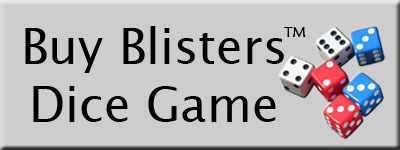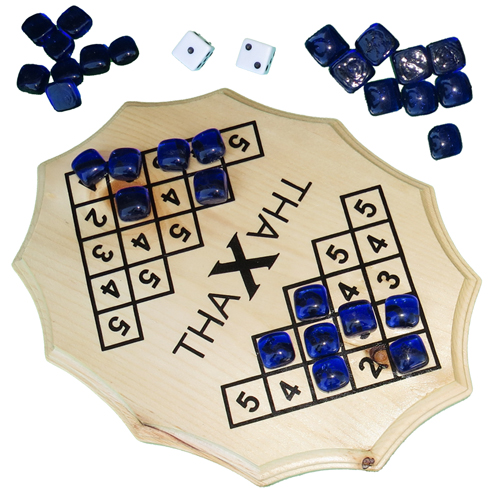The object of THAX is to be the first to cover their side of the gameboard. Pieces are placed on (and sometimes removed from) the board using the numbers on the dice.
Gameplay summary:
After rolling for first turn, players take turns rolling the dice and placing pieces on the board. Using the numbers rolled on the dice, players can place both numbers as pieces on their side of the board or take a piece from the opponent’s side and place it on their side. The numbers can also be added to place a piece on that numbered space on their side of the board. Sixes are not on the board and mean nothing when rolled. Roll double sixes, called a Thax, and you must take a piece from your side of the board. When a player rolls any doubles other than sixes, that player gets another turn.
Parts needed: 30 “game pieces” (coins, stones, buttons, etc), Thax game board, a pair of dice.
Here’s a list of possible rolls:
Place 2 pieces on spaces using the numbers rolled on the dice.
Example: A two and a three are rolled. The player places a piece on an uncovered “two” space and a piece on an uncovered “three” space on their side of the board.
Take 1 piece from your opponent’s side of the board and place it on their side of the board using numbers rolled on the dice.
Example: A two and a three are rolled. The player takes a piece covering a “two” space from the opponent’s side and places it on an uncovered “three” space on their own side of the board. (Or take a three from the opponent’s side and place it on their own uncovered “two” space.)
Add the two dice numbers together and place a piece on that uncovered space on their side of the board.
Example: A two and a three are rolled. Add them together to make five and place a piece on an uncovered “five” space on their side of the board.
A six is one of the dice numbers rolled. (called a “half thax”) Since sixes mean nothing, the other number is used to place a piece on their side of the board.
Example: A six and five are rolled. The six has no space and means nothing. A piece is placed on an uncovered “five” space on their side of the board.
Double sixes. You must take a piece of your choice off of your side of the board.
This is called a “thax”.
If you don’t have an uncovered space for a number you’ve rolled, you can’t place a piece. It is not uncommon to find you cannot place anything because you don’t have the uncovered space to place a piece on. To take a piece from your opponent’s side, you must have an uncovered space to place it. Example: If you roll a three and a two and want to take a “two” from your opponent, you must have the uncovered “three” space to place that piece on. If you get stuck on a turn, look at the list of possible rolls above and see if your roll can apply.
A Game of THAX

See how the sample dice rolls listed below might be played.
If either player rolls double sixes, they must remove a piece (from any number) from their side of the board.
If Player A rolls a 3 and 5, he can either: A.) Place a piece on his uncovered “three” space and a piece on his uncovered “five” space. B.) Take a piece from Player B’s covered “five” space and place it on his own uncovered “three” space. C.) Take a piece from Player B’s covered “three” space and place it on his own uncovered “five” space.
If Player B rolls a 2 and a 3, he can either: A.) Place a piece on his uncovered “two” space and a piece on his uncovered “three” space. B.) Add the dice numbers together to make 5 and place a piece on his uncovered “five” space. C.) Take a piece from Player A’s covered “three” space and place it on his own uncovered “two” space. Player B cannot take a “two” from Player A because they don’t have any!
If Player A were to roll double 4s, there are pieces covering all the four spaces on his side so there are no moves for him to make. In order to take a piece from your opponent, you must have an uncovered space to place it on. Since he rolled doubles, however, he gets to roll again.
If Player A rolls a 6 and a 4, there are no uncovered “four” spaces on his side and the 6 is a dead number so there are no moves to make.
If Player B rolls double 5s, he can either: A.) Take a piece from Player A’s covered “five” space and place it on their own uncovered “five” space. B.) Place pieces on two of the uncovered “five” spaces. Remember, roll doubles (except 6s), you roll again after moving pieces.
If Player A rolls double 1s, the only move he can make is to combine the dice and cover up a “two” space on his side. Because they rolled doubles, this player gets to roll again.
If player A rolls a 3 and a 1, the only move he can make is to place a piece on a “three” space on their side since their “one” position is already covered
Copyright © 1996, 2022 by Tim A Novak






